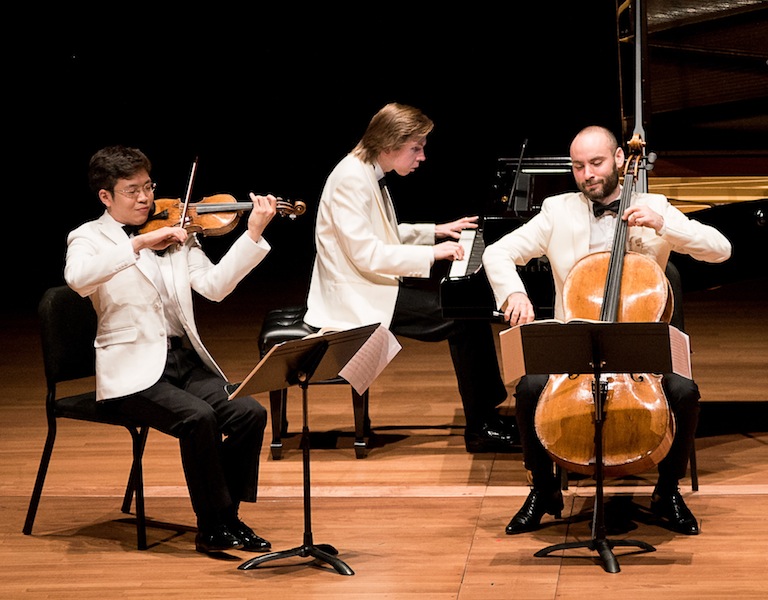Chamber Music Society opens new summer series in populist vein

Violinist Paul Huang, pianist Juho Pohjonen and cellist Jakob Koranyi performed Beethoven’s Piano Trio in E flat, Op. 70, no. 2, in the Chamber Music Society of Lincoln Center concert Wednesday night at Alice Tully Hall. Photo: Cherylynn Tsushima
It’s not true that New York City spends its summer in the Hamptons. The city that never sleeps never really takes a vacation, and summer is one of the most substantial times for classical music, with the Lincoln Center and Mostly Mozart festivals filling up July and August.
The two now have a junior partner, though one that’s been around for a long time: the Chamber Music Society of Lincoln Center. Their first summer season opened Wednesday night at Alice Tully Hall, with a program of meat-and-potatoes classics from Mozart, Beethoven, and Schubert. And with so many music lovers in town, the concert was sold out.
Laid out chronologically and in order of increasing size and duration, the CMS musicians played Mozart’s Sonata for Violin and Piano, K. 378, Beethoven’s Piano Trio in E flat major, Op. 70, No. 2, and, in the second half, the Schubert “Trout” Quintet, D. 667, for piano, violin, viola, cello, and bass.
The one constant in these scores is the piano, and pianist Juho Pohjonen was the linchpin of the concert, in no small part responsible for the superb performances throughout. Pohjonen played with clarity and rhythmic sureness. He was both a sensitive accompanist and a firm, but unobtrusive, leader.
His virtues were immediately apparent in the opening Mozart sonata, performed with violinist Erin Keefe. The pianist’s playing was notably elegant, ideal for the music and reminiscent of the great Géza Anda. Stylistically, Keefe was at times at odds with Pohjonen. Her playing expressed a natural inclination towards a more romantic sound and phrasing, and through the first section of the opening movement, the two musicians at times were not on the same stylistic page.
They were not solely responsible. Although CMS co-artistic director Wu Han praised the sound of the hall, and it can hold a hefty crowd, Alice Tully is not the best venue for chamber music. The reflection does not favor all instruments equally: the piano sounded fine, but the violin felt recessed in comparison, with too much reverb and too little immediacy. The acoustic separation between the two instruments reinforced the interpretive distances. (The hall has also been plagued the past couple years by a mysterious, rapid metallic ringing that is more bothersome than a swarm of smart phones.)
Once the main statement of the music repeated, though, the musicians came together, Pohjonen’s playing exerted a gravity of musical logic and expression, and as the unanimity increased, the performance improved. From merely pleasant, the playing became compellingly lyrical in the second movement, then vibrant in the Rondo finale.
The performance of the Beethoven Trio was cohesive and concentrated from the start. Pohjonen was joined by violinist Paul Huang and cellist Jakob Koranyi, and the absolute clarity of articulation in the pianist’s playing was central to the music’s satisfaction. A companion to Beethoven’s mysterious “Ghost” trio, the music is full of a gentle introspection not common to the composer’s middle period. While the musicians played with soulfulness, especially in the third movement, the hall’s acoustic pressed an inappropriately heavy weight onto the sound. Pohjonen cut through this, and lifted it away.
After intermission, Keefe returned, joined by violist Roberto Diaz and bassist Timothy Cobb (with Pohjonen and Koranyi) for Schubert’s Quintet. The volume and weight of the larger ensemble made for the best fit in the hall, and the musicians’ communication was projected with ease. The balance between the instruments proved ideal as well, and Diaz in particular stood out, with a woody, moody sound and shapely phrasing in the Andante.
Shapely was the watchword for the concert overall. None of the interpretations were idiosyncratic or surprising, but all were cogent, intelligent and extremely well played. Tempos were so ideal that one never took notice of them, and the musicians had a complete grasp of the harmonic structures, carving great, long arches through time.
This led to some interesting interaction in the crowd, who were soaking in the pleasures of the music. Schubert’s finale has a false ending, and when it arrived the crowd burst into loud applause. The musicians, some clearly amused, kept going, and that moment also made the crowd more attentive, hanging on to the music for every last bit of satisfaction.
The CMS Summer Evenings series continues July 19 with a program of Haydn, Mendelssohn and Mozart, and July 22 with music of Dvorak, Schumann, and Brahms. chambermusicsociety.org